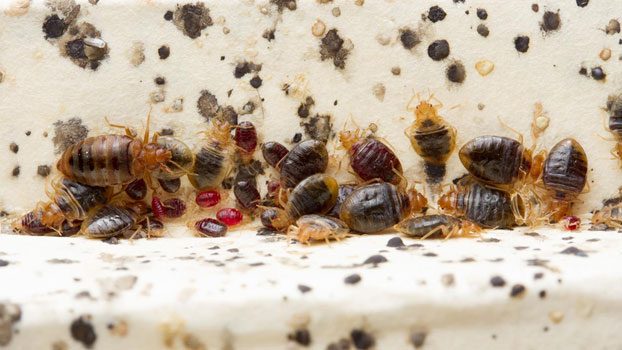Specialist Bed Bug Exterminator Near Me: DC Exterminator Solutions
Wiki Article
Discovering the Science Behind Bed Pest Warm Treatments as a Lasting Insect Monitoring Technique
One such method that has actually gained traction in recent years is the use of warm therapies to battle bed pest infestations. The complexities of exactly how warm successfully removes bed pests and the more comprehensive implications for lasting pest management practices make this a topic worth exploring even more.Bed Bug Heat Treatment Process

Thermal Fatality Point for Bed Pests
Subjecting bed pests to elevated temperature levels beyond their thermal resistance range is vital for achieving efficient eradication in warm therapy processes. The thermal fatality factor for bed bugs describes the temperature at which these bugs can not endure. Research study shows that bed bugs begin to die when exposed to temperature levels over 113 ° F(45 ° C) for a continual duration. As the temperature boosts, so does the mortality rate of bed pests. At around 118 ° F(48 ° C ), bed bugs begin to pass away rapidly, with a mortality price of nearly 99% within minutes of direct exposure. This demonstrates the sensitivity of bed pests to high temperature levels and highlights the effectiveness of warmth treatments in removing problems. By reaching and maintaining temperatures over the thermal fatality factor for bed pests, pest administration specialists can ensure extensive removal of bed pest populations, including hard-to-reach areas where chemical treatments may be less efficient. Comprehending the thermal fatality factor for bed pests is essential for executing successful warm treatment methods and accomplishing lasting bug management end results.Benefits of Warm Treatments
Having developed the important thermal death point for bed pests, it is critical to currently explore the substantial benefits that warm treatments use in efficiently eliminating these resistant bugs. Heat therapies present numerous crucial benefits when contrasted to traditional chemical approaches. One of the main benefits is that warm can pass through deep into holes and cracks where bed pests hide, making sure that even the most hard-to-reach locations are heated to dangerous temperatures. This detailed approach not just eliminates live insects but likewise browse around these guys targets bed pest eggs, preventing future invasions.Additionally, warm therapies are safe and eco friendly, making them a sustainable insect administration approach. Unlike chemical pesticides, warmth therapies do not leave hazardous residues that can position dangers to human health and wellness or the atmosphere. This element is especially crucial in delicate atmospheres such as health centers, colleges, and houses where chemical usage might not be preferable.
Furthermore, warm treatments have a high success rate in eliminating bed bug infestations in a solitary therapy, lowering the requirement for several sees and lessening interruption to residents. This efficiency not only conserves money and time however also provides tranquility of mind to those managing bed pest issues.
Effectiveness of Heat Therapy

click for more Study research studies have actually constantly demonstrated the efficiency of heat therapies in achieving a high price of bed bug death. Correctly performed heat therapies can get to all the fractures and crevices where bed insects might be harboring, ensuring a detailed approach to extermination. In addition, warm therapies have actually the added advantage of eliminating bed insect eggs, which are usually resistant to typical chemical treatments. In general, the performance of warmth treatments in eliminating bed pest infestations makes them a reputable and lasting insect administration approach.
Lasting Pest Management Benefits
Carrying out sustainable insect management techniques uses long-lasting benefits for both the setting and public wellness. By using methods such as warmth therapies for insect control, we can reduce the dependence on dangerous chemical pesticides that can have unfavorable effects on ecosystems and human wellness - bed bug heat treatment. Sustainable parasite administration techniques aid in maintaining biodiversity by targeting particular parasites without hurting non-target organisms, consequently maintaining a well balanced community
Furthermore, lasting pest administration practices add to the overall wellness and well-being of the general public. By minimizing direct exposure to harmful chemicals made use of in standard parasite control techniques, warmth treatments give a much safer alternative for bug management in property, commercial, and public rooms. This reduction in chemical use also assists in preventing pesticide deposits from polluting soil, air, and water, securing ecological quality.
Final Thought
Finally, bed insect warmth treatments have been shown to be a reliable and lasting bug monitoring strategy. The thermal death point for bed insects makes them at risk to heat treatments, which have various benefits over typical chemical therapies. The effectiveness of heat treatments in getting rid of bed insect invasions while reducing ecological influence highlights the potential of this method as a sustainable solution for pest control.The bed bug heat treatment process involves raising the temperature within infested areas to a level that effectively eliminates bed bugs and their eggs. By getting to and keeping temperature levels over the thermal fatality factor for bed bugs, pest administration specialists can make certain detailed removal of bed insect populations, including hard-to-reach locations where chemical therapies might be less effective. One of the primary benefits is that warmth can permeate deep into cracks and crevices where bed insects hide, guaranteeing that even the most hard-to-reach locations are heated up to lethal temperatures. Unlike chemical therapies read what he said that may leave behind resistant populaces, warm treatments offer a safe and ecologically friendly remedy that can permeate deep into furnishings, wall surfaces, and other hard-to-reach locations where bed insects hide.
The thermal fatality point for bed pests makes them prone to heat therapies, which have many advantages over typical chemical treatments.
Report this wiki page